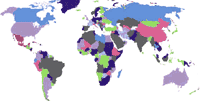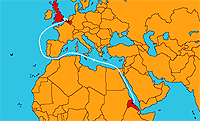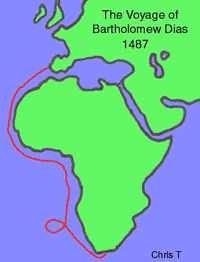South Africa’s Maritime History

 The Suez Canal allows for ships from Europe to travel to the East with ease. Before the canal was opened European ships had to travel around the southern tip of Africa to reach their destination. Source: top image, www.thomas.maritime.free.fr and bottom image, www.womankind.org.uk
The Suez Canal allows for ships from Europe to travel to the East with ease. Before the canal was opened European ships had to travel around the southern tip of Africa to reach their destination. Source: top image, www.thomas.maritime.free.fr and bottom image, www.womankind.org.uk
South Africa's history is closely tied to European colonial and economic expansion since the 1400s. This growth was partly possible due to the development of trade and sea routes. Before the opening of the Suez Canal in 1869 the safest and most feasible sea route between Europe and the East ran past the southern tip of Africa, and South Africa played a critical role in world economy, trade and politics.
Portuguese explorers rounded southern Africa for the first time about 500 years ago in their search for a sea route to the East. They paved the way for thousands of seafaring vessels from many countries. Due to natural and human reasons shipwrecks on the South African coast occurred often. Since 1500 more than 2 300 vessels have been lost along our coast. These wrecks included vessels from about 38 different countries and they provide invaluable information about the Dutch, English and French East India Companies, as well as Portuguese explorers. They also yield data about the British Royal Navy, 19 th century passenger and mail shipping services, and First and Second World War shipping. Coastal vessels connected to fishing, whaling, mining and agriculture are of local interest as they show the expanding needs and growth of these industries.
It may also be that vessels from the Indian Ocean could have sunk on our shores. The Portuguese on the east African coast, especially Mozambique, encountered several Arab sea traders and it seems unlikely that they would not have sailed further south, towards KwaZulu Natal and even the Cape East Coast. If they did some of these vessels could have been lost along the South African shore long before, and after, the arrival of Europeans.
 In 1487 and 1488 Bartholmew Dias, a Portuguese explorer, circumnavigated the southern tip of Africa and named it the Cape of Good Hope. This was a major breakthrough in the search for a trade route from Europe to the East. Source: www.esd.k12.ca.us
In 1487 and 1488 Bartholmew Dias, a Portuguese explorer, circumnavigated the southern tip of Africa and named it the Cape of Good Hope. This was a major breakthrough in the search for a trade route from Europe to the East. Source: www.esd.k12.ca.us
All shipwrecks are fragile and non-renewable. They are of great national and international archaeological and cultural import and it is essential that they are preserved.